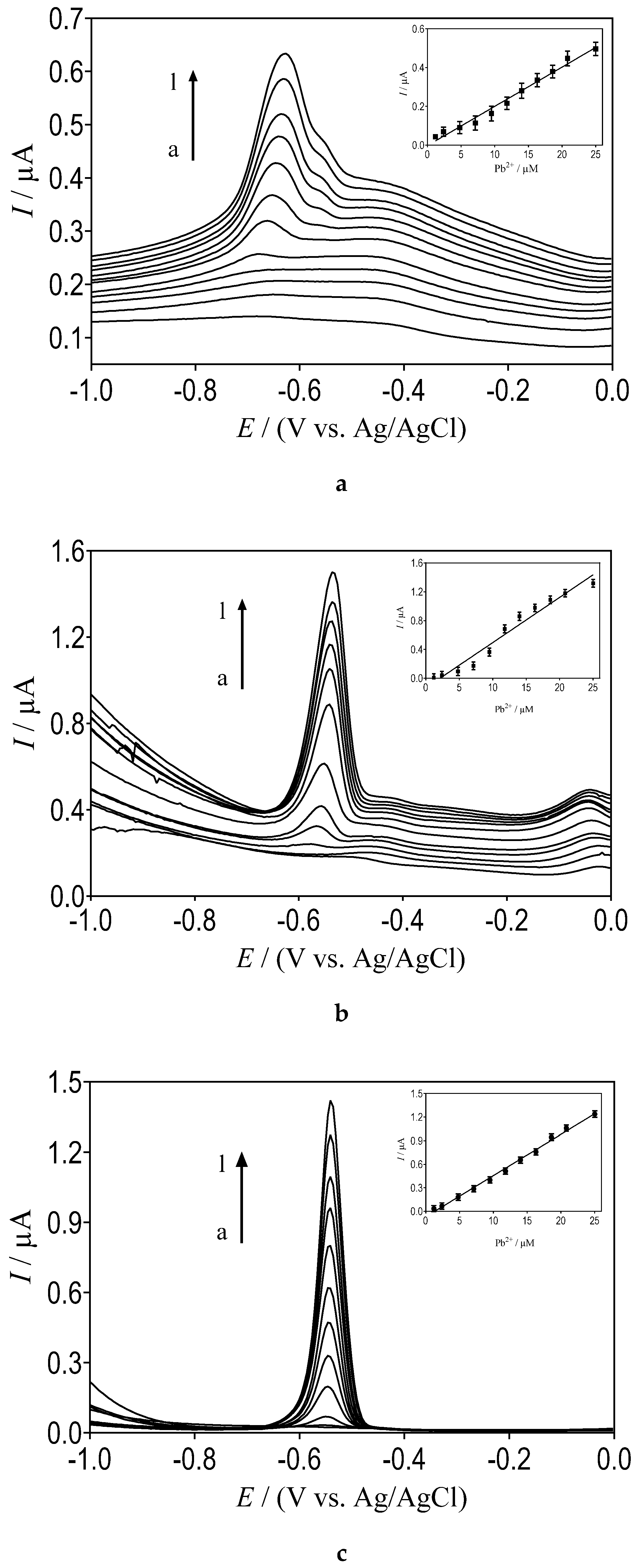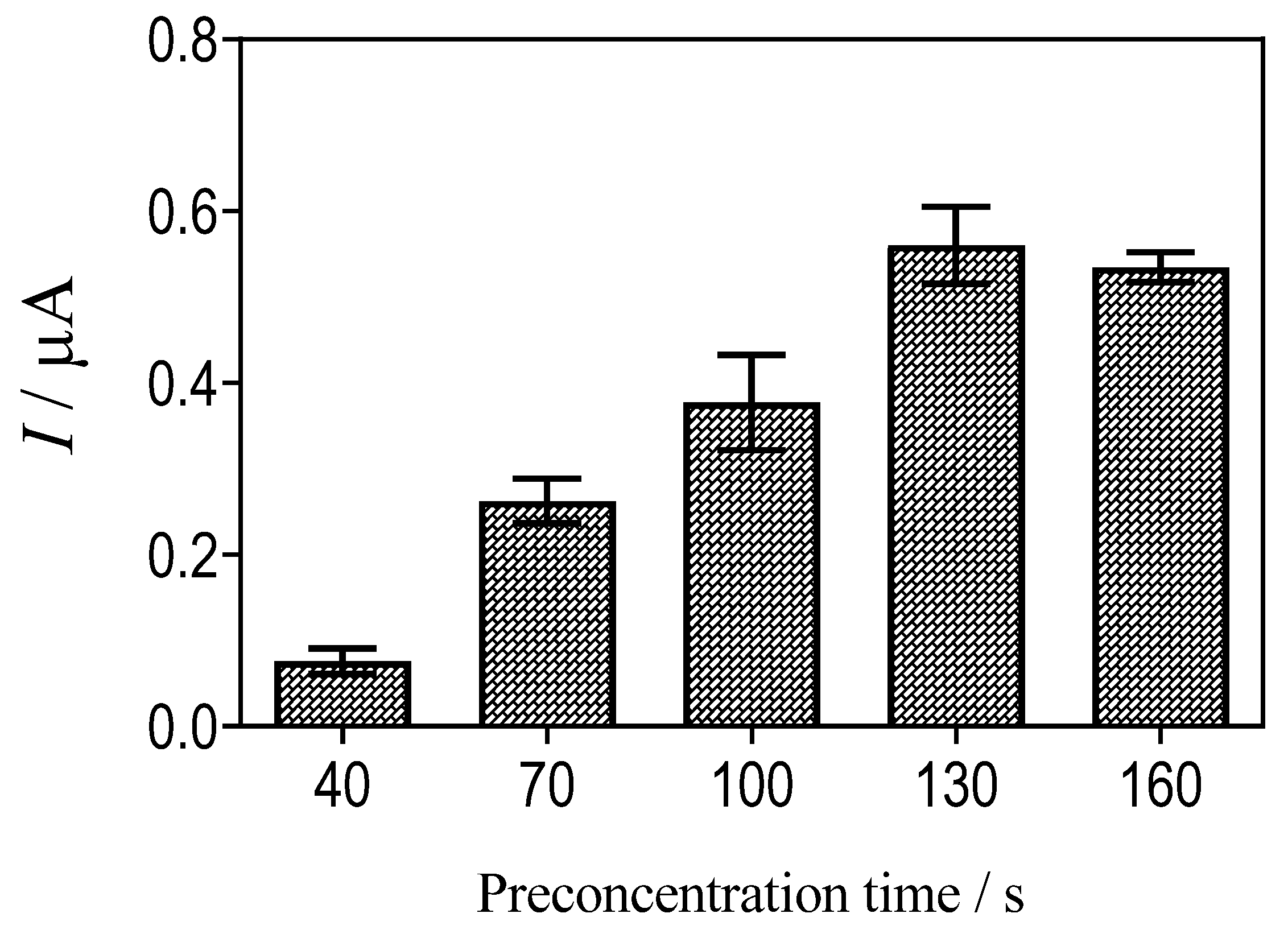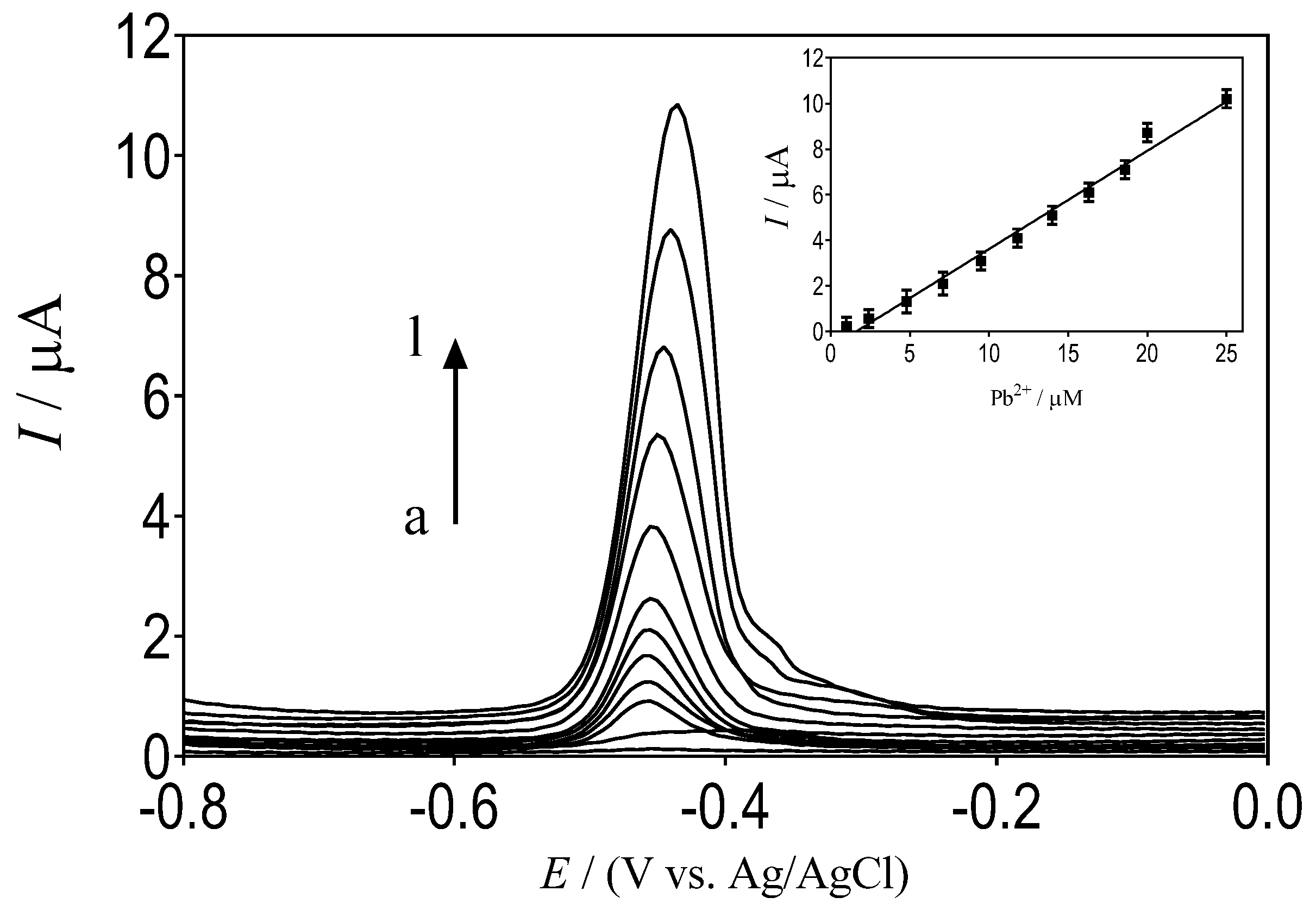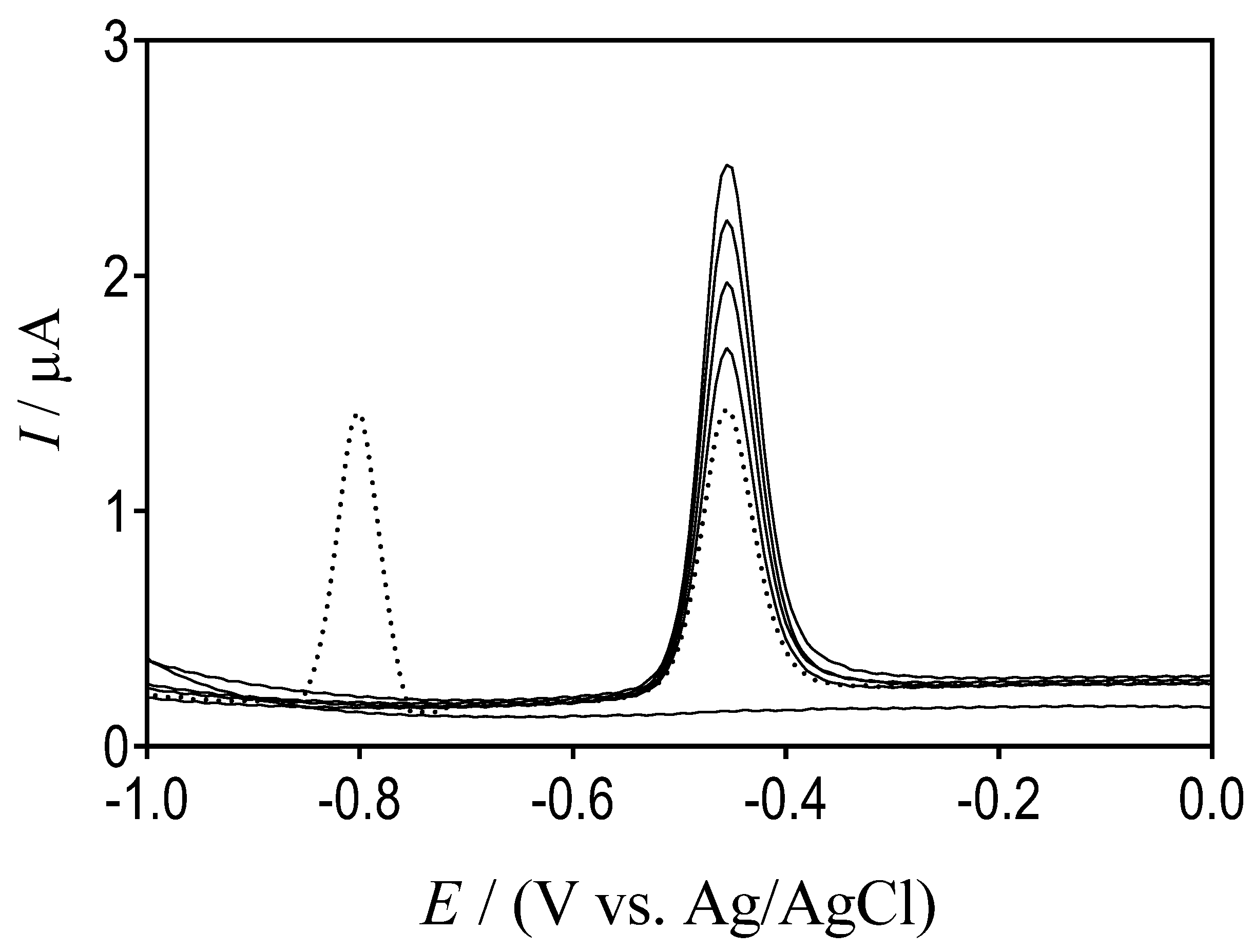Electrochemical Determination of Lead Using A Composite Sensor Obtained from Low-Cost Green Materials:Graphite/Cork
Abstract
:1. Introduction
2. Materials and Methods
2.1. Preparation of Cork-Modified Electrodes
2.2. Electrochemical Measurements
3. Results and Discussion
3.1. Effect of the Supporting Electrolyte
3.2. Influence of the Preconcentration Time
3.3. Influence of the Cork Concentration
3.4. SWASV Analysis
3.5. Study of the Interferences
3.6. Stability
3.7. Analytical Applications
4. Conclusions
Author Contributions
Funding
Acknowledgments
Conflicts of Interest
References
- Gupta, R. Reproductive and Developmental Toxicology, 1st ed.; Ramesh Gupta, Ed.; Academic Press: Cambridge, MA, USA, 2017. [Google Scholar]
- Khoshbin, Z.; Housaindokht, M.R.; Verdian, A.; Bozorgmehr, M.R. Simultaneous detection and determination of mercury(II) and lead(II) ions through the achievement of novel functional nucleic acid-based biosensors. Biosens. Bioelectron. 2018, 116, 130–147. [Google Scholar] [CrossRef]
- Pinho, S.; Ladeiro, B. Phytotoxicity by lead as heavy metal focus on oxidative stress. J. Bot. 2012, 2012, 1–10. [Google Scholar] [CrossRef]
- Tangahu, B.V.; Sheikh Abdullah, S.R.; Basri, H.; Idris, M.; Anuar, N.; Mukhlisin, M. A review on heavy metals (As, Pb, and Hg) uptake by plants through phytoremediation. Int. J. Chem. Eng. 2011, 2011. [Google Scholar] [CrossRef]
- Fan, R.D.; Liu, S.Y.; Du, Y.J.; Reddy, K.R.; Yang, Y.L. Impacts of presence of lead contamination on settling behavior and microstructure of clayey soil—calcium bentonite blends. Appl. Clay Sci. 2017, 142, 109–119. [Google Scholar] [CrossRef]
- Chisholm-brause, C.J.; Hayes, K.I.M.F.; Lawrence, A. Spectroscopic investigation of Pb(II) complexes at the γA12O3/water interface. Geochim. Cosmochim. Acta 1990, 54, 1897–1909. [Google Scholar] [CrossRef]
- Roto, R.; Mellisani, B.; Kuncaka, A.; Mudasir, M.; Suratman, A. Colorimetric sensing of Pb2+ ion by using ag nanoparticles in the presence of dithizone. Chemosensors 2019, 7, 28. [Google Scholar] [CrossRef] [Green Version]
- Krachler, M.; Irgolic, K.J. The potential of inductively coupled plasma mass spectrometry (ICP-MS) for the simultaneous determination of trace elements in whole blood, plasma and serum. J. Trace Elem. Med. Biol. 1999, 13, 157–169. [Google Scholar] [CrossRef]
- L’vov, B.V. Fifty years of atomic absorption spectrometry. J. Anal. Chem. 2005, 60, 382–392. [Google Scholar] [CrossRef]
- Beltrán, B.; Leal, L.O.; Ferrer, L.; Cerdà, V. Determination of lead by atomic fluorescence spectrometry using an automated extraction/pre-concentration flow system. J. Anal. At. Spectrom. 2015, 30, 1072–1079. [Google Scholar] [CrossRef]
- Dai, X.; Wu, S.; Li, S. Progress on electrochemical sensors for the determination of heavy metal ions from contaminated water. J. Chin. Adv. Mater. Soc. 2018, 6, 91–111. [Google Scholar] [CrossRef]
- Silva, K.N.O.; Paiva, S.S.M.; Souza, F.L.; Silva, D.R.; Martínez-Huitle, C.A.; Dos Santos, E.V. Applicability of electrochemical technologies for removing and monitoring Pb2+ from soil and water. J. Electroanal. Chem. 2018, 816, 171–178. [Google Scholar] [CrossRef]
- Monteiro, M.K.S.; Santos, E.C.M.M.; Silva, D.R.; Martínez-Huitle, C.A.; Dos Santos, E.V. Simultaneous determination of paracetamol and caffeine in pharmaceutical formulations and synthetic urine using cork-modified graphite electrodes. J. Solid State Electrochem. 2020, 18–20. [Google Scholar] [CrossRef]
- Araújo, E.G.; Jhones dos Santos, A.; da Silva, D.R.; Salazar, R.; Martínez-Huitle, C.A. Cysteic acid-modified glassy carbon electrode for monitoring oxalic acid (OA) concentration during its electrochemical oxidation at Ti/Pt anode. Electroanalysis 2014, 26, 748–755. [Google Scholar] [CrossRef]
- Araújo, E.G.; Oliveira, G.R.; Santos, E.V.; Martínez-Huitle, C.A.; Panizza, M.; Fernandes, N.S. Applicability of electroanalysis for monitoring oxalic acid (OA) concentration during its electrochemical oxidation. J. Electroanal. Chem. 2013, 701. [Google Scholar] [CrossRef] [Green Version]
- March, G.; Nguyen, T.D.; Piro, B. Modified electrodes used for electrochemical detection of metal ions in environmental analysis. Biosensors 2015, 5, 241–275. [Google Scholar] [CrossRef] [PubMed] [Green Version]
- Palisoc, S.; Vitto, R.I.M.; Natividad, M. Determination of heavy metals in herbal food supplements using bismuth/multi-walled carbon nanotubes/Nafion modified graphite electrodes sourced from waste batteries. Sci. Rep. 2019, 9, 1–13. [Google Scholar] [CrossRef] [PubMed]
- Yantasee, W.; Lin, Y.; Hongsirikarn, K.; Fryxell, G.E.; Addleman, R.; Timchalk, C. Electrochemical sensors for the detection of lead and other toxic heavy metals: The next generation of personal exposure biomonitors. Environ. Health Perspect. 2007, 115, 1683–1690. [Google Scholar] [CrossRef] [Green Version]
- Koirala, K.; Santos, J.H.; Tan, A.L.; Ali, M.A.; Mirza, A.H. Chemically modified carbon paste electrode for the detection of lead, cadmium and zinc ions. Sens. Rev. 2016, 36, 339–346. [Google Scholar] [CrossRef]
- Nery, E.W.; Kundys-Siedlecka, M.; Furuya, Y.; Jönsson-Niedziółka, M. Pencil lead as a material for microfluidic 3D-electrode assemblies. Sensors 2018, 18, 4037. [Google Scholar] [CrossRef] [PubMed] [Green Version]
- Palisoc, S.; Gonzales, A.J.; Pardilla, A.; Racines, L.; Natividad, M. Electrochemical detection of lead and cadmium in UHT-processed milk using bismuth nanoparticles/Nafion®-modified pencil graphite electrode. Sens. Bio-Sens. Res. 2019, 23, 100268. [Google Scholar] [CrossRef]
- Batista, L.C.D.; Santos, T.I.S.; Santos, J.E.L.; da Silva, D.R.; Martínez-Huitle, C.A. Metal Organic Framework-235 (MOF-235) modified carbon paste electrode for catechol determination in water. Electroanalysis 2021, 33, 57–65. [Google Scholar] [CrossRef]
- Monteiro, M.K.S.; Paiva, S.S.M.; da Silva, D.R.; Vilar, V.J.P.; Martínez-Huitle, C.A.; Dos Santos, E.V. Novel cork-graphite electrochemical sensor for voltammetric determination of caffeine. J. Electroanal. Chem. 2019, 839, 283–289. [Google Scholar] [CrossRef]
- Henrique, J.M.M.; Monteiro, M.K.S.; Cardozo, J.C.; Martínez-Huitle, C.A.; da Silva, D.R.; Dos Santos, E.V. Integrated-electrochemical approaches powered by photovoltaic energy for detecting and treating paracetamol in water. J. Electroanal. Chem. 2020, 876, 114734. [Google Scholar] [CrossRef]
- Pintor, A.M.A.; Ferreira, C.I.A.; Pereira, J.C.; Correia, P.; Silva, S.P.; Vilar, V.J.P.; Botelho, C.M.S.; Boaventura, R.A.R. Use of cork powder and granules for the adsorption of pollutants: A review. Water Res. 2012, 46, 3152–3166. [Google Scholar] [CrossRef]
- Gil, L. New cork-based materials and applications. Materials 2015, 8, 625–637. [Google Scholar] [CrossRef] [PubMed] [Green Version]
- Marat-Mendes, J.N.; Neagu, E.R. The study of electrical conductivity of cork. Ferroelectrics 2003, 294, 123–131. [Google Scholar] [CrossRef]
- Danzer, K.; Currie, L.A. Guideline for calibration in analytical chemistry—Part 1. Fundamentals and single component calibration. Pure Appl. Chem. 1998, 70, 993–1014. [Google Scholar] [CrossRef]
- Currie, L.A. International Union of Pure and Applied Chemistry Nomenclature in Evaluation of Analytical Methods Including Detection and Quantification Capabilities. Pure Appl. Chem. 1995, 67, 1699–1723. [Google Scholar] [CrossRef]
- Desimoni, E.; Brunetti, B. About estimating the limit of detection of heteroscedastic analytical systems. Anal. Chim. Acta 2009, 655, 30–37. [Google Scholar] [CrossRef] [PubMed]
- Brunetti, B.; Desimoni, E. Voltammetric determination of vitamin B6 in food samples and dietary supplements. J. Food Compos. Anal. 2014, 33, 155–160. [Google Scholar] [CrossRef]
- Pintor, A.M.A.; Vieira, B.R.C.; Brandaõ, C.C.; Boaventura, R.A.R.; Botelho, C.M.S. Complexation mechanisms in arsenic and phosphorus adsorption onto iron-coated cork granulates. J. Environ. Chem. Eng. 2020, 8, 104184. [Google Scholar] [CrossRef]
- Pintor, A.M.A.; Silvestre-Albero, A.M.; Ferreira, C.I.A.; Pereira, J.P.C.; Vilar, V.J.P.; Botelho, C.M.S.; Rodríguez-Reinoso, F.; Boaventura, R.A.R. Textural and surface characterization of cork-based sorbents for the removal of oil from water. Ind. Eng. Chem. Res. 2013, 52, 16427–16435. [Google Scholar] [CrossRef]
- Monteiro, M.K.S.; Da Silva, D.R.; Quiroz, M.A.; Vilar, V.J.P.; Martínez-Huitle, C.A.; Dos Santos, E.V. Applicability of cork as novel modifiers to develop electrochemical sensor for caffeine determination. Materials 2021, 14, 37. [Google Scholar] [CrossRef]
- Morante-Zarcero, S.; Pérez-Quintanilla, D.; Sierra, I. A disposable electrochemical sensor based on bifunctional periodic mesoporous organosilica for the determination of lead in drinking waters. J. Solid State Electrochem. 2015, 19, 2117–2127. [Google Scholar] [CrossRef]
- Salmanipour, A.; Taher, M.A. An electrochemical sensor for stripping analysis of Pb(II) based on multiwalled carbon nanotube functionalized with 5-Br-PADAP. J. Solid State Electrochem. 2011, 15, 2695–2702. [Google Scholar] [CrossRef]
- Oularbi, L.; Turmine, M.; El Rhazi, M. Electrochemical determination of traces lead ions using a new nanocomposite of polypyrrole/carbon nanofibers. J. Solid State Electrochem. 2017, 21, 3289–3300. [Google Scholar] [CrossRef] [Green Version]
- Baś, B.; Jakubowska, M. The renovated silver ring electrode in determination of lead traces by differential pulse anodic stripping voltammetry. Anal. Chim. Acta 2008, 615, 39–46. [Google Scholar] [CrossRef] [PubMed]
- Al-Gahouari, T.; Bodkhe, G.; Sayyad, P.; Ingle, N.; Mahadik, M.; Shirsat, S.M.; Deshmukh, M.; Musahwar, N.; Shirsat, M. Electrochemical sensor: L-cysteine induced selectivity enhancement of electrochemically reduced graphene oxide–multiwalled carbon nanotubes hybrid for detection of lead (Pb2+) ions. Front. Mater. 2020, 7. [Google Scholar] [CrossRef] [Green Version]
- Ghanei-Motlagh, M.; Taher, M.A. An electrochemical sensor based on novel ion imprinted polymeric nanoparticles for selective detection of lead ions. Anal. Bioanal. Chem. Res. 2017, 4, 295–306. [Google Scholar] [CrossRef]
- Rahm, C.E.; Torres-Canas, F.; Gupta, P.; Poulin, P.; Alvarez, N.T. Inkjet printed multi-walled carbon nanotube sensor for the detection of lead in drinking water. Electroanalysis 2020, 32, 1533–1545. [Google Scholar] [CrossRef]





| Electrodes | Method | Electrolyte | Linear Range µM | LOD/µM | Ref. |
|---|---|---|---|---|---|
| MTZ-PMO-S-S 1 | SWASV | 0.2 M HCl | 0.01–10 | 0.024 | [35] |
| 5-Br-PADAP/MWCNT 2 | DPA | 0.1 M acetate buffer | 0.9–114 | 0.5 | [36] |
| PPy/CNFs/CPE 3 | SWASV | 0.1 M acetate buffer | 0.2–130 | 0.05 | [37] |
| SRE 4 | DPASV | 0.01 M HNO3 + 0.01 M KCl | 0.01−0.1 | 0.02 | [38] |
| Glassy carbon | ADSV | 0.5 M NaNO3 | 0.5 | [12] | |
| ErGO–MWNTs–L-cys 5 | DPASV | 0.1 M acetate buffer | 0.2–40 | 0.05 | [39] |
| CPE modified with IIP-MWCNTs 6 | DPSV | 0.1 M acetate buffer | 3–55 | 0.5 | [40] |
| IJP-MW-CNT 7 | SWASV | 0.1 M acetate buffer | 5–20 | 0.05 | [41] |
| GrRAC | SWASV | 0.5 M H2SO4 | 1–25 | 0.3 | This work |
| Sample | Present Method 1 | Pb2+ Added (µM) | Pb2+ Found (µM) 1 | Recovery (%) |
|---|---|---|---|---|
| Groundwater | Not detected | 10 | 11.5 ± 0.3 | 115 |
| 50 | 52.1 ± 1.8 | 104 | ||
| Tap water | Not detected | 10 | 10.8 ± 0.5 | 108 |
| 50 | 50.4 ± 1.5 | 100 | ||
| Produced water | 12.0 ± 0.4 µM | 10 | 19.6 ± 0.5 | 89 |
| 50 | 60.3 ± 2.1 | 97 |
Publisher’s Note: MDPI stays neutral with regard to jurisdictional claims in published maps and institutional affiliations. |
© 2021 by the authors. Licensee MDPI, Basel, Switzerland. This article is an open access article distributed under the terms and conditions of the Creative Commons Attribution (CC BY) license (http://creativecommons.org/licenses/by/4.0/).
Share and Cite
Silva, I.B.; de Araújo, D.M.; Vocciante, M.; Ferro, S.; Martínez-Huitle, C.A.; Dos Santos, E.V. Electrochemical Determination of Lead Using A Composite Sensor Obtained from Low-Cost Green Materials:Graphite/Cork. Appl. Sci. 2021, 11, 2355. https://doi.org/10.3390/app11052355
Silva IB, de Araújo DM, Vocciante M, Ferro S, Martínez-Huitle CA, Dos Santos EV. Electrochemical Determination of Lead Using A Composite Sensor Obtained from Low-Cost Green Materials:Graphite/Cork. Applied Sciences. 2021; 11(5):2355. https://doi.org/10.3390/app11052355
Chicago/Turabian StyleSilva, Iasmin B., Danyelle Medeiros de Araújo, Marco Vocciante, Sergio Ferro, Carlos A. Martínez-Huitle, and Elisama V. Dos Santos. 2021. "Electrochemical Determination of Lead Using A Composite Sensor Obtained from Low-Cost Green Materials:Graphite/Cork" Applied Sciences 11, no. 5: 2355. https://doi.org/10.3390/app11052355







